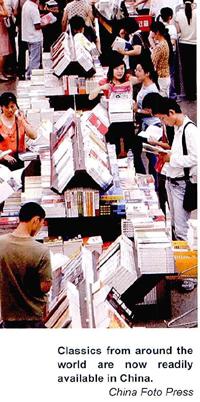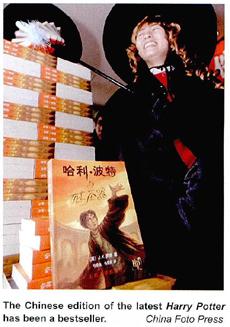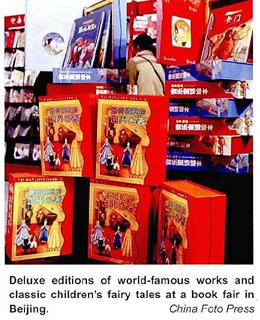Classic Foreign Literature in China
staff reporter LU RUCAI

CLASSIC foreign literature is big business in present-day China, with countless editions by small publishing houses competing with versions released by long-established state publishing firms. Literature from overseas is nothing new in China; late Qing Dynasty scholar Lin Shu (1852-1924) published 222 Chinese versions of foreign works in his lifetime, including 160 novels. Lin was the first to publish a local translation of a classic Western novel, with the release of The Lady of the Camellias in 1900. His other translations included works by famous novelists such as Charles Dickens and English playwright William Shakespeare. Lin had to rely on oral translations of others, however, as he did not understand foreign languages himself.
In the first decade or so of the Peoples Republic of China, certain works from the Soviet Union and Latin America were popular. Since China adopted the policy of reform and opening-up in 1978, works of literature from around the world have become widely available. Whats more, the vast Chinese market has become increasingly attractive to foreign publishers.
Penguin Enters a Crowded Market
In August 2006, the Penguin Group of Britain and Chinas Chongqing Publishing Group signed a cooperation agreement that will see the two jointly publish the Penguin Classics series in China. The first batch of 10 works set out in the deal included Jane Eyre and The Sorrows of Young Werther. By the time the classics series was actually launched in early 2008, the number of titles in the inaugural batch had increased to 30.
The Penguin Group regards China as a long-term market, where it hopes to build “Penguin Books” as a brand accorded the kind of recognition it enjoys throughout the English-speaking world. The release of the “Penguin Classics” in Chinese is the first step in this strategy. The initial batch of 30 works will be published in 2008. Penguin then plans to publish an additional 30 titles from around the world annually for five years, which will include both classic and contemporary novels.

Even before the arrival of the Penguin Group in China, large bookstores in Beijings busy Wangfujing and Xidan shopping areas were crowded with many editions of famous foreign novels, such as Stendhals The Red and the Black and Victor Hugos The Hunchback of Notre Dame. More and more small to medium-sized publishers have jumped on the “classic works” bandwagon, joining well-established publishing companies such as the Peoples Literature Publishing House, the Shanghai Translation Publishing House and the Yilin Press.
Liu Bingyuan, assistant to the editor-in-chief of the Yutian Hanfeng Books Co., Ltd. under the Tongxin Publishing House, explains the appeal of these titles for small publishing houses: “Copyright on these works has long expired, the Chinese translations are ready, and these books are absolutely long-term bestsellers.”
How the Steel Was Tempered by Russian novelist Nikolai Ostrovsky, for example, has sold nearly 10 million copies in various versions. Classic childrens titles can be particularly lucrative, and many publishing houses give priority to this area. The company for which Liu Bingyuan works is actually the childrens section of the Tongxin Publishing House. The books it has published include Hans Christian Andersens Fairy Tales, Aesops Fables, A Thousand and One Nights, and Around the World in 80 Days. Since 2004, the Yutian Hanfeng Books Co., Ltd. has printed more than 100,000 illustrated copies each of the aforementioned titles. Print runs for certain works have been as high as 200,000 or even 300,000 copies. For a small or medium-sized publisher this is a considerable amount, and profits can be handsome.

So how will the Penguin Group distinguish itself within this crowded market? The company hopes their editions of classic titles will stand out from the pack by virtue of their quality translations, authoritative introductions and copious footnotes.
Older Translations the Best?
The bookshelf of Cao Xiaoping, a middle-school student, holds many famous works of literature. Each title has at least two or three versions by different publishers. Cao Xiaoping has compared various editions of the same titles, and despite superficial variations in price and appearance, has found many of the translations to be almost the same. Differences are usually subtle ones of phrasing. One edition, for example, translated a particular phrase as “the next day,” while in another it was rendered as “the following day.” “Translations of the same book by different publishing houses are a waste of resources, arent they?” asks Cao rhetorically.
For publishers, however, repetition is by no means a waste. “This is a profit-driven business,” says an anonymous publisher emphatically. “For classic titles the only cost is the paper and printing. There is no spending on royalties, and little on editing and translation. Sales can last years or even decades.” He adds that copying one anothers translations is an “open secret” in the publishing industry. Novels such as Camellia and Pride and Prejudice have been published in 10 to 20 versions in China. The Red and the Black has been published in 70 to 80 different translations. As long as a title sells, there are publishers who want to “re-translate” it.
Cao Xiaopings mother is in her early 40s. As a youth she loved literature, and was deeply moved by the characters in How the Steel Was Tempered. She still remembers certain paragraphs by heart. “At that time, translators of foreign works were masters of both Chinese and foreign languages. Their translations were much better than the versions published now,” she claims.
Liu Bingyuan concurs with this assessment. “Most readers still regard the earliest translations published by the Peoples Literature Publishing House as the best,” he says. The company still has a competent force of translators, but in Chinas contemporary market-driven environment, the monopoly the publisher once enjoyed over Chinas translating resources is fading by the day. Nevertheless, Liu Bingyuan believes publishing classics is a basic task of publishing houses, and repetitions are unavoidable. The new forms they adopt now or in the future will depend on market demand.
Foreign Awards, Chinese Bestsellers
The Chinese market for foreign literature isnt all about classics. In October 2007, it was announced that British writer Doris Lessing had been awarded the Nobel Prize for literature. Gu Aibin, president of the Nanjing-based Yilin Press specializing in publishing Chinese translations of foreign works, immediately decided to increase the number of copies being printed of Lessings The Golden Notebook. Meanwhile, he ordered his staff to obtain the rights for two of her other books, The Grass Is Singing and Mara and Dannian Adventure. At the same time, the Beijing Big Apple Copyright Agency, Doris Lessings agent on the Chinese mainland, received over 100 calls from publishers. Among them were the Yilin Press and the Shanghai Translation Publishing House. Both wished to renew their contracts. Other publishers were seeking to publish Lessings books for the first time.
Initial print runs for The Golden Notebook and The Grass Is Singing were 5,000-6,000 copies each. Sales were low and no reprints were ordered. But as elsewhere in the world, the Nobel imprimatur can have a big impact on sales. In 2004, Austrian writer Elfriede Jelinek won the prize, and her novel The Piano Teacher went on to sell 100,000 copies on the Chinese mainland. When Turkish writer Orhan Pamuk took the award in 2006, his novel My Name Is Red went on to sell more than 300,000 copies and is still on the list of bestsellers. A few days after Lessing won the Nobel Prize, a line was added to the cover of the reprinted The Golden Notebook, reading: “A representative work of the 2007 Nobel Laureate Doris Lessing.”
The release of Lessings work in China is part of Yilins strategy of publishing key contemporary foreign works. After Yilin released its “Foreign Classic Literature Series,” the firm began purchasing the copyrights on contemporary foreign novels in 1996. In the years since, the company has bought the rights to nearly 300 titles. Royalty advances for Lessings books have ranged from US $1,000 to $1,200. The Yilin Press has now launched the “Latest Foreign Bestsellers Series,” featuring foreign works of literature translated as soon as they are published.
Yilin is not the only firm to have moved into overseas contemporary literature. The Peoples Literature Publishing House organizes specialists from literature circles to vote annually for the best foreign novels of the 21st century. Each year, six of the best novels published in Europe, North America and Latin America are selected for translation and publication in China. More than 30 titles have been released so far, and sales are steadily rising, proving that quality literature can successfully straddle language and cultural barriers. As German writer Christoph Peters said at the award ceremony when his novel Fabric of Night was selected as the best contemporary foreign novel in 2003, “The road from one culture to another is shorter than we had imagined.”
“The growth in the number of titles published reflects the prosperity of the foreign languages publishing industry. The growing market also brings fierce competition. To keep pace with foreign bestsellers has become a market demand,” says Liu Kaihua, director of the foreign languages editorial office of the Peoples Literature Publishing House. The positive result of this for Chinese readers is a range of foreign bestsellers unimaginable a few decades ago. According to statistics from the Archival Library of Chinese Publications, from 1978 to 1990 China published 28,500 translated works. From 1995 to 2008, more than 100,000 newly translated works have been published (excluding re-translations and works with multiple translations), averaging 10,000 new titles a year.
Its not just foreign literature thats increasingly popular in China. According to 2005 figures submitted by publishing houses nationwide, 83 percent of the 6,737 titles imported from abroad were in the field of humanities and social sciences, 21 percent of them being works of literature. Novels are among the highest-selling titles however. The Chinese edition of the Harry Potter series sold 10 million copies, reaping a profit of RMB 20-30 million, while Norwegian Wood, by Japanese novelist Haruki Murakami, sold more than 1 million copies. The motivational parable Who Moved My Cheese? sold 3.6 million copies.
Theres no doubt both classic and contemporary foreign literature has become a permanent feature of Chinas publishing landscape. While the countrys opening-up has seen the market flooded with translations of varying quality, the past few decades have also exposed local readers to a wealth of foreign stories, ideas and cultures. For the discerning reader, this boom in foreign titles has provided a treasure trove of internationally flavored reading pleasure

